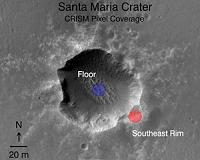 |
Pasadena CA (JPL) Jan 05, 2011 The High Resolution Imaging Science Experiment (HiRISE) camera on NASA's Mars Reconnaissance Orbiter captured a Dec. 31, 2010, view of the Mars Exploration Rover Opportunity on the southwestern rim of a football-field-size crater called "Santa Maria." Opportunity arrived at the western edge of Santa Maria crater in mid-December and will spend about two months investigating rocks there. Opportunity is imaging the crater's interior to better reveal the geometry of rock layers as a means of defining the stratigraphy and the impact process. Santa Maria is a relatively young, 90-meter-diameter (295-foot-diameter) impact crater. Note the blocks of ejected material around the crater. It is old enough to collect sand dunes in its interior. Santa Maria crater, located in Meridiani Planum, is about 6 kilometers (4 miles) from the rim of the much larger Endeavour crater, Opportunity's long-term destination. The rim of Endeavour contains spectral indications of phyllosilicates, or clay bearing minerals believed to have formed in wet conditions that could have been more habitable than the later acidic conditions in which the sulfates Opportunity has been exploring formed. Data from the Compact Reconnaissance Imaging Spectrometer for Mars, which is also on the Mars Reconnaissance Orbiter, show indications of hydrated sulfates on the southeast edge of the Santa Maria crater. The rover team plans to use Opportunity to investigate that area through the solar conjunction period in late January and early February. During that period, Mars is almost directly behind the sun from Earth's perspective, and commanding from Earth to Mars spacecraft is restricted. After that, Opportunity will traverse to the northwest rim of Endeavour crater, aided tremendously by HiRISE images like this for navigation and targeting interesting smaller craters along the way. That investigation will take Opportunity into the beginning of its eighth year on Mars. Opportunity landed in the Meridiani Planum region of Mars on Jan. 25, 2004, Universal Time (Jan. 24, Pacific Time) for a mission originally planned to last for three months. Opportunity and its twin, Spirit, which passed its seventh anniversary on Mars this week, both have made important discoveries about wet environments on ancient Mars that may have been favorable for supporting microbial life.
Share This Article With Planet Earth
Related Links Mars Exploration Rovers Mars News and Information at MarsDaily.com Lunar Dreams and more
 NASA Spacecraft Provides Travel Tips For Mars Rover
NASA Spacecraft Provides Travel Tips For Mars RoverSan Francisco CA (SPX) Dec 31, 2010 NASA's Mars Opportunity rover is getting important tips from an orbiting spacecraft as it explores areas that might hold clues about past Martian environments. Researchers are using a mineral-mapping instrument aboard NASA's Mars Reconnaissance Orbiter to help the rover investigate a large ancient crater called Endeavour. The orbiter's Compact Reconnaissance Imaging Spectrometer for Mars ( ... read more |
|
| The content herein, unless otherwise known to be public domain, are Copyright 1995-2010 - SpaceDaily. AFP and UPI Wire Stories are copyright Agence France-Presse and United Press International. ESA Portal Reports are copyright European Space Agency. All NASA sourced material is public domain. Additional copyrights may apply in whole or part to other bona fide parties. Advertising does not imply endorsement,agreement or approval of any opinions, statements or information provided by SpaceDaily on any Web page published or hosted by SpaceDaily. Privacy Statement |